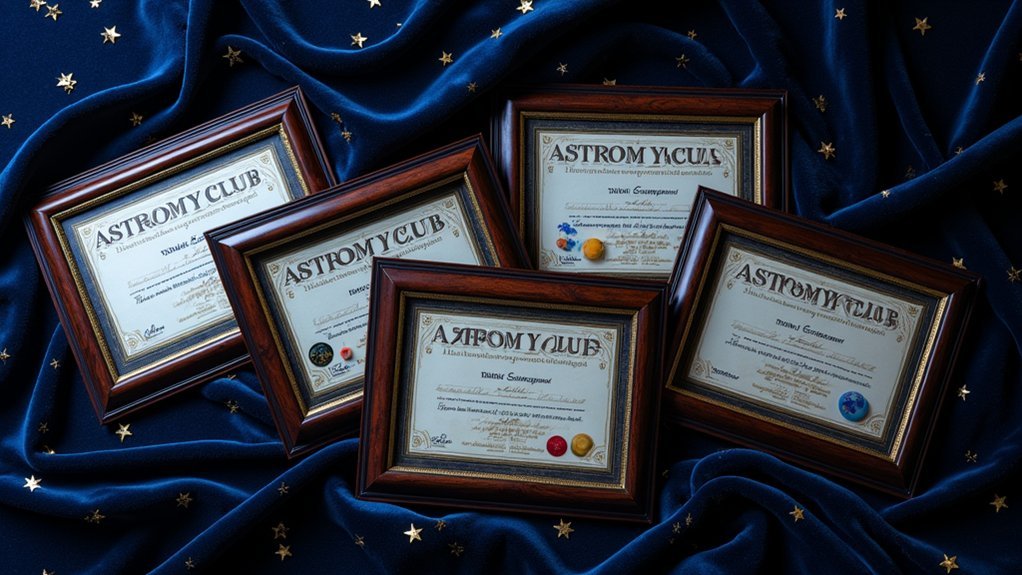To grasp light-year distances, try three simple approaches: First, use scale models—imagine the Sun-Earth distance as just one inch, making a light-year 63,360 miles long. Second, understand time-based analogies—light takes 8 minutes from Sun to Earth, but 4.24 years from Proxima Centauri. Third, explore interactive simulations that visualize cosmic journeys at light speed. These tools transform mind-boggling astronomical measurements into concepts you’ll actually comprehend.
Scale Models: Shrinking the Universe to Backyard Size

Five extraordinary scale comparisons can help you grasp the mind-boggling distances of our universe.
If you shrink one astronomical unit (Earth to Sun) to just one inch, a light-year stretches 63,360 miles—over 1,000 times Earth’s circumference.
In a 100,000-inch Milky Way model, Proxima Centauri sits just 4.24 inches away, while light from this nearest star takes over four years to complete its journey toward Earth at the speed of light.
Looking farther, the Andromeda Galaxy would be 2,500 miles away in this scale, illustrating the vast distances in space between galaxies.
Even more impressive, the Hercules Galaxy Cluster would appear approximately 500 miles distant, demonstrating how galaxy clusters create the universe’s largest structures.
Time-Based Analogies: From Light Seconds to Light Years
Time offers another powerful way to comprehend astronomical distances. When you hear that light travels approximately 299,792 kilometers per second, you’re glimpsing a fundamental measuring tool for space.
The Moon sits just one light-second away—meaning light takes only one second to reach Earth from its surface. Venturing further, a light-minute spans 17.99 million kilometers through the void. These units help you grasp closer astronomical units within our solar system.
For stars, we need light-years—the staggering 9.46 trillion kilometers light travels in a year.
Consider Proxima Centauri, our nearest stellar neighbor at 4.24 light-years away. This means the starlight you’re seeing began its journey more than four years ago, despite being the closest star to us.
Interactive Simulations: Traveling at the Speed of Light

While numbers alone can overwhelm our understanding, interactive simulations provide a dynamic way to grasp cosmic distances. You can experience how light travels through our universe by manipulating time and distance in these digital tools.
| Destination | Distance | Travel Time at Light Speed |
|---|---|---|
| Sun to Earth | 93 million miles | 8 minutes |
| Proxima Centauri | 4.24 light-years | 4.24 years |
| Andromeda Galaxy | 2.5 million light-years | 2.5 million years |
Interactive simulations let you explore how far away stars appear as they existed in the past. When you observe the Andromeda Galaxy, you’re seeing it as it was 2.5 million light-years ago. These tools help you visualize the distance light travels in one year—5.88 trillion miles—making the vast scale of our universe more comprehensible.
Frequently Asked Questions
How to Comprehend a Light-Year?
To comprehend a light-year, imagine light traveling for an entire year—that’s 5.88 trillion miles. You’re seeing stars as they existed years ago. It’s the universe’s way of measuring cosmic distances.
How Do You Find the Distance Traveled by Light in a Light-Year?
To find a light-year’s distance, you’ll multiply the speed of light (186,000 miles/second) by seconds in a year (31.5 million). That’s about 5.88 trillion miles – the distance light travels in one year.
How Long Would It Take to Travel 1 Lightyear?
You’d need precisely one year traveling at light speed (186,000 miles/second). At 10% light speed, it’d take 10 years. On our fastest spacecraft, you’re looking at about 6,700 years to cover one light-year.
How to Visualize 1 Light-Year?
To visualize one light-year, imagine your light beam circling Earth 7.5 times in one second, then continuing that speed for an entire year. That’s 5.88 trillion miles—about 63,000 times the Sun-Earth distance.
In Summary
You’ve now explored three powerful ways to comprehend the vastness of light-year distances. Whether you’re creating scale models in your backyard, visualizing time-based comparisons, or experimenting with interactive simulations, you’ll find these tools transform abstract cosmic measurements into tangible concepts. Next time you gaze at the stars, you won’t just see pinpoints of light—you’ll understand the true scale of our magnificent universe.





Leave a Reply